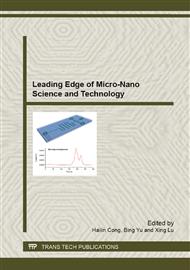[1]
R. Wirth, Focused Ion Beam (FIB): A novel technology for advanced application of micro-and nano-analysis in geosciences and applied mineralogy, Eur Jour Mineral, 16 (2004) 863-876.
DOI: 10.1127/0935-1221/2004/0016-0863
Google Scholar
[2]
B. Bhushan, Nanotribology and nanomechanics, Wear. 259 (2005) 1507-1531.
DOI: 10.1016/j.wear.2005.01.010
Google Scholar
[3]
N. Kambe, Highly uniform nano-structured building blocks of metal and their compounds, Script Mater. 44 (2001) 1671-1675.
DOI: 10.1016/s1359-6462(01)00880-6
Google Scholar
[4]
H. R. Wenk, Are pseudotachylites products of fracture of fusion? Geology. 6 (1978) 507-511.
Google Scholar
[5]
B.B. Bakken, M. F. Hochella, Jr. A. F Marshall, High-resolution microscopy of gold in unoxidized ore from the Carlin mine, Nevada Econ Geol., 84 (1989) 171-179.
DOI: 10.2113/gsecongeo.84.1.171
Google Scholar
[6]
C. Y. Wang, Y. Sun, Oriented micro-fracture in Cajon Pass drill cores: stress field near the San Andreas Fault, J Geophys Res. 95 (1990) 11135-11142.
DOI: 10.1029/jb095ib07p11135
Google Scholar
[7]
H. P. Ge, Y. Sun, X. C. Lu, W. B. Zhu, Guo Jichun, Discovery and analysis of ultra-micro grinding grain texture in sliding lammelae of ductile-brittle zone, Sci China Ser D-Earth Sci. 47 (2004) 265-271.
DOI: 10.1360/02yd0159
Google Scholar
[8]
S. D. Mair, S. Abe, 3D numerical simulations of fault gouge evolution during shear: Grin size reduction and strain cocalization, Earth and Planetary Science Letter, 274 (2008) 72-81.
DOI: 10.1016/j.epsl.2008.07.010
Google Scholar
[9]
R. Yund, M. Blanpied, T. Tullis, et al., Amorphous material in high strain experimental fault gouges, J. Geophysices Res. 95 (1990) 15589-15602.
DOI: 10.1029/jb095ib10p15589
Google Scholar
[10]
Y. Sun, X. C. Lu, X. H. Zhang, H. Liu, A. M. Lin, Nano-texture of penetrative foliation in metamorphic rocks, Science in China Ser D- Earth Sci. 51 (2008) 1750-1758.
DOI: 10.1007/s11430-008-0138-9
Google Scholar
[11]
J. Hippett, C. Lana, T. Takeshita, Deformation partitioning during folding of banded iron formation, J. Struct Geol. 23 (2001) 820-834.
DOI: 10.1016/s0191-8141(00)00128-0
Google Scholar
[12]
M. L. Willians, E. A. Mells, C.F. Kopf, Microstructural tectonometamorphic process and the development of geneissic layering: A mechanism for metamorphic segregation, J. Metamo Geol. 18 (2000) 41-57.
DOI: 10.1046/j.1525-1314.2000.00235.x
Google Scholar
[13]
M. L. Cooke, C. A Underwood, Fracture termination and step over at bedding interface due to frictional slip and interface opening, J. struct Geol. 23 (2001) 223-238.
DOI: 10.1016/s0191-8141(00)00092-4
Google Scholar
[14]
C. Viti, T. Hirose, Thermal deformation of serpentine during coseismic faulting: Nanostructures and mineral reactions, J. Struct Geol. 32 (2010) 1476-1484.
DOI: 10.1016/j.jsg.2010.09.009
Google Scholar
[15]
P. R. Dawson, Modeling deformation of polycrystalline rocks, Rev Miner Geochem. 51 (2002) 331-52.
Google Scholar
[16]
M. Stewart, R. E. Holdsworth, R. A. Strachan, Deformation processes and weakening mechanisms within the frictional-viscous transition zone of major crystal-scale fault: Insights from the Great Glen Fault Zone, Scotland, J Struct Geol. 22 (2000).
DOI: 10.1016/s0191-8141(99)00164-9
Google Scholar
[17]
N. Mandal, S. K. Samanta, C. Chakraborty, Numerical modeling of heterogeneous flow fields around rigid objects with special reference to particle paths strain shadows and foliation drag, Tectonophysics. 330 (2001) 177-94.
DOI: 10.1016/s0040-1951(00)00223-7
Google Scholar
[18]
K. O' Hara, Reaction weakening and emplacement of crystalline thrusts: Diffusion control on reaction rate and strain, J Struct Geol. 29 (2007) 1301-1334.
DOI: 10.1016/j.jsg.2007.04.004
Google Scholar
[19]
H. R. Green, C. Marona, Instability of deformation, Rev Miner Geochem. 51(2002) 181-220.
Google Scholar
[20]
N. Kambe, Highly uniform nano-stuctured building blocks of metal-(O, C, N, S) and their complex compounds, Script Materialia. 44 (2001) 1671-1675.
DOI: 10.1016/s1359-6462(01)00880-6
Google Scholar
[21]
S. Veprek, A. Niederhofer, K. Moto, et al., Composition nanostructure and origin of ultrahardness in nc-TiN/a –Si3N4/a-nc-TiSi2 anocomposites with Hv=80 to ≥105 GPa, Surf Coat Tech. 133-134 (2001) 152-9.
DOI: 10.1016/s0257-8972(00)00957-9
Google Scholar
[22]
E. Kusano, M. Kitagawa, A. Satoh, et al., Hardness of compositionally nano-modulated TiN, Nano-struct Mat. 12 (1999) 807-10.
DOI: 10.1016/s0965-9773(99)00240-8
Google Scholar
[23]
J. Musil, Hard and superhard nano composite coating, Surf Coat Tech. 125 (2000) 322-30.
Google Scholar
[24]
S. Y. Tarassov, A.V. Kolubaev, Effect of on subsurface layer microstructure in austenitic and martensitic steels, Wear. 231 (1999) 228-234.
DOI: 10.1016/s0043-1648(99)00107-6
Google Scholar
[25]
A. M. Schlecher, V. der. Pluijm, L. N. Warr, Nanocoatings of clay and creep of the San Andreas Fault at Park field, California, Geology, 38 (2010) 667-670.
DOI: 10.1130/g31091.1
Google Scholar
[26]
G. Yielding, B. Freeman, T. Needham, Quantitative fault seal predication, AAPG Bulletin. 81 (1997) 897-917.
Google Scholar


